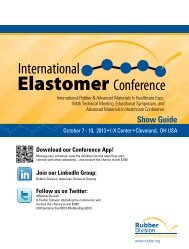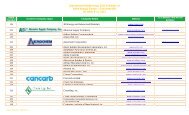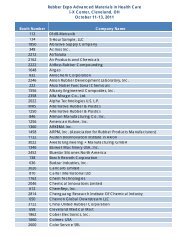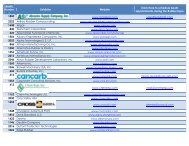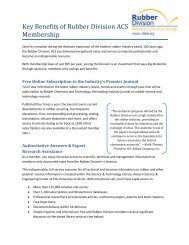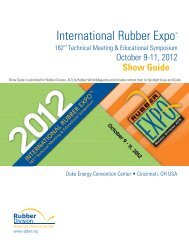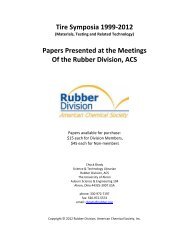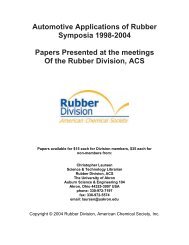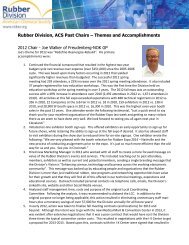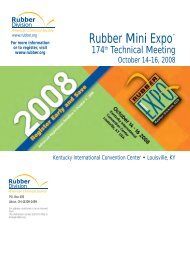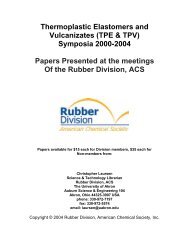Training Directory - Rubber Division
Training Directory - Rubber Division
Training Directory - Rubber Division
Create successful ePaper yourself
Turn your PDF publications into a flip-book with our unique Google optimized e-Paper software.
PROPERTIES, ANALYSIS & TESTING<br />
Chemistry and Technology of<br />
Polyurethane Elastomers<br />
4 hours or 8 hours<br />
CEUs: .4 or .8<br />
The course focuses on the fundamentals of elastomeric<br />
polyurethanes such as those used in coatings adhesives,<br />
sealants or elastomers (“CASE”). The course includes<br />
identifi cation of major raw materials, an introduction to polymer<br />
chemistry and chemical structure-property relationships in<br />
elastomeric polyurethanes. Testing and analysis techniques,<br />
typical formulary and key processing methods are discussed in the<br />
context key markets such as medical device, oil fi eld, materials<br />
handling, architectural, and materials handling applications.<br />
Those Who Should Attend:<br />
Product engineers, managers, quality professionals and Jr. or<br />
Sr. level chemists. Suggested pre-requisites include general<br />
technical aptitude and general familiarity of technical terminology<br />
related to chemistry and rubber or plastic materials.<br />
Course Outline:<br />
1. Introduction: CASE market overview<br />
2. Polymer and functional group chemistry of polyurethanes<br />
3. Structure-property relationships and key raw materials<br />
4. Testing and analytical methods<br />
5. Processing Methods<br />
6. Case examples of typical polyurethane formulary.<br />
Introduction to Dispersions<br />
4 hours<br />
CEUs: .4<br />
This course will start with a detailed explanation about how<br />
dispersion is accomplished in rubber, including both liquids and<br />
solids. Next, each type of dispersion will be studied, including<br />
the common carriers and their capabilities. When discussing the<br />
polymer bound dispersion, several polymer types and combination<br />
will be examined. Finally, each type of dispersion will be explored<br />
as to their benefi ts and limitations.<br />
Introduction to Design of<br />
Experiments<br />
Webinar<br />
If you are a compounder, chemist, process engineer, factory<br />
troubleshooter, manufacturing supervisor, research or technical<br />
manager, you should consider this seminar.<br />
This seminar focuses on:<br />
• Review of Basic Statistics<br />
• What are Designed Experiments<br />
Introduction to Design of<br />
Experiments<br />
8 hours or 16 hours<br />
CEUs: .8 or 1.6<br />
If you are a compounder, chemist, process engineer, factory<br />
troubleshooter, manufacturing supervisor, research or technical<br />
manager, you should consider this seminar.<br />
This seminar focuses on:<br />
• Review of Basic Statistics<br />
• What are Designed Experiments<br />
Key To Symbols<br />
Online Registration<br />
Certifi cate/CEUs Awarded<br />
On-site<br />
E-learning<br />
International<br />
<strong>Rubber</strong> <strong>Division</strong>, ACS training programs are learning<br />
events, and a certificate and CEUs are awarded<br />
to participants upon successful completion of the<br />
program. No test is given and participants are<br />
not certified.<br />
12 RUBBER DIVISON, ACS EDUCATION OPPORTUNITIES



